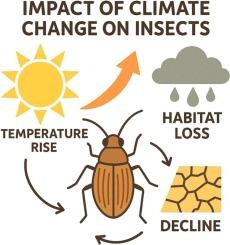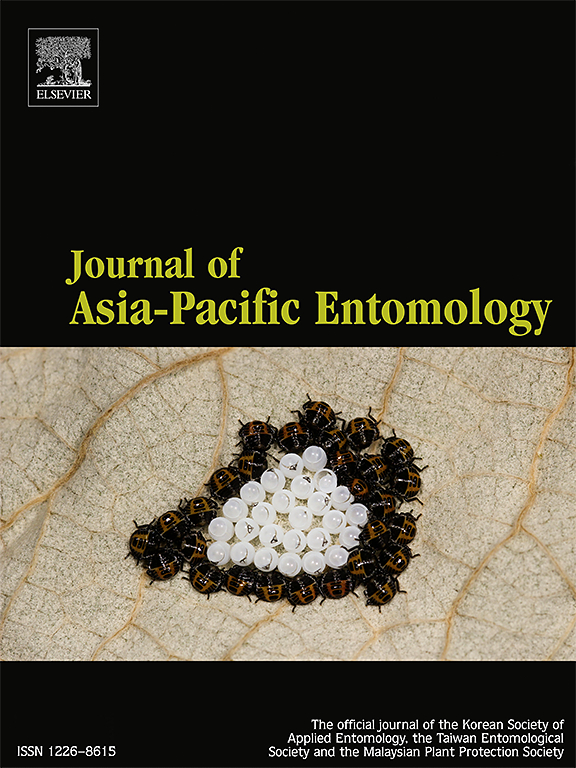Effect of global climate change on insect populations, distribution, and its dynamics
IF 1.3
3区 农林科学
Q3 ENTOMOLOGY
引用次数: 0
Abstract
Insects are vital to various ecosystems as pollinators, decomposers, and food sources for many organisms. They dominate diverse terrestrial (e.g., glassland) and aquatic (lakes, oceans, rivers, etc.) ecosystems. Previous studies report that more than half of the estimated 2.0 million species of living organisms identified on our planet are insects. However, global climate change (GCC), characterised by rising temperatures and altered precipitation patterns, significantly impacts their populations worldwide. We reviewed the literature to provide an overview of GCC events in insects. Collectively, the study findings reveal that global temperature and precipitation change are among the extreme GCC events affecting more than 30% of insect population, distribution, physiology, feeding habits, interactions, migration, and communication across the globe. The climate change intensifies insect cycles and insect damage in agroecosystems. In response, insect species alter their geographic ranges and phenology, changing population dynamics and interactions. GCC also influences reproductive patterns, including mating behaviour and breeding synchrony. Warmer global temperatures might advance or delay insect emergence, causing mismatches with food availability or pollination partners. While some insect populations may adapt, extreme heat events or prolonged droughts exceeding their physiological tolerance result in population declines or local extinctions. Predictions suggest that up to 65% of insect populations could face extinction within the next century due to increasing climate change. Thus, understanding these impacts is essential for predicting the ecological consequences of the GCC and developing effective conservation strategies to mitigate such impacts and protect insect biodiversity and ecosystem services.

全球气候变化对昆虫种群、分布及其动态的影响
昆虫作为传粉者、分解者和许多生物的食物来源,对各种生态系统至关重要。它们支配着各种陆地(如玻璃地)和水生(湖泊、海洋、河流等)生态系统。先前的研究报告称,在我们这个星球上发现的大约200万种生物体中,有一半以上是昆虫。然而,以气温上升和降水模式改变为特征的全球气候变化(GCC)显著影响了它们在世界范围内的种群。我们回顾了文献,提供了昆虫GCC事件的概述。总的来说,研究结果表明,全球温度和降水变化是影响全球30%以上昆虫种群、分布、生理、摄食习性、相互作用、迁徙和交流的极端GCC事件之一。气候变化加剧了农业生态系统的昆虫周期和昆虫破坏。作为回应,昆虫物种改变了它们的地理范围和物候,改变了种群动态和相互作用。GCC还影响生殖模式,包括交配行为和繁殖同步。全球气温升高可能会提前或推迟昆虫的出现,导致与食物供应或授粉伙伴的不匹配。虽然一些昆虫种群可能会适应,但极端高温事件或超过其生理耐受性的长期干旱会导致种群数量下降或局部灭绝。预测表明,由于气候变化加剧,多达65%的昆虫种群可能在下个世纪面临灭绝。因此,了解这些影响对于预测海湾合作委员会的生态后果以及制定有效的保护策略以减轻这些影响并保护昆虫生物多样性和生态系统服务至关重要。
本文章由计算机程序翻译,如有差异,请以英文原文为准。
求助全文
约1分钟内获得全文
求助全文
来源期刊

Journal of Asia-pacific Entomology
Agricultural and Biological Sciences-Insect Science
CiteScore
2.70
自引率
6.70%
发文量
152
审稿时长
69 days
期刊介绍:
The journal publishes original research papers, review articles and short communications in the basic and applied area concerning insects, mites or other arthropods and nematodes of economic importance in agriculture, forestry, industry, human and animal health, and natural resource and environment management, and is the official journal of the Korean Society of Applied Entomology and the Taiwan Entomological Society.
 求助内容:
求助内容: 应助结果提醒方式:
应助结果提醒方式:


